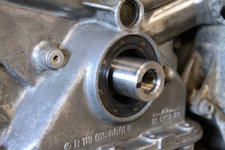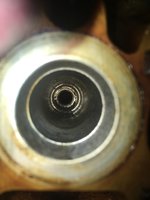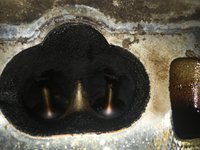Hello all.
I got a '94 E420 a year ago. 160k miles. No paperwork or previous owner information besides the service booklet that came with the car and has nothing since 1995. I only drove it around the block before parking it as the brake pedal sank to the floor and gave that feeling that one never wants to get from a brake pedal. I'm guessing that that is how the previous owner got into the tap in the front and wound up totaling the car. I replaced the master cylinder and leaking caliper which caused this.
I had to pull the engine and transmission from the car for unrelated work.
My intent was to address everything that time dictates to do to these cars with respect to mileage. Among it was the timing chain + rails/guides. Only thing is that after I've put the engine at 45 degrees, all the pins line up. Completely with no adjustment to the engine. Which was not what I was expecting. She did sound and drive great both times I did but I was expecting a little bit of stretch which I'm not seeing.
This car has not been abused but also not maintained well. There is so much varnish in the engine that it's obvious that oil changes were not a priority. Everything is original to the engine except for thermostat, lower pan gasket and miscellaneous vacuum lines. I am doing everything that should be done to this engine before I put it in as I do not want to go near this thing (a V8 has no business being in that car) with a wrench for as long as I have to. Without getting into detail, it's over $1k in parts so far and I'm getting another list ready which could total the same amount. So I'm addressing everything that should be for peace of mind and intended operation.
Should I leave the timing chain alone? If it had stretch I'd have no problem with doing it but spending the time and money to do this when it's not showing any signs of wear seems unproductive. I'm doing the water pump even though it's fine and eyeing the rear seal with the same regard so it's not like I'm trying to put work off. I also might only put 50-75k miles on this car. I'm not selling it but it's also not my only car so there will be rotation going on.
Just looking for some opinions from the experts.
Thank you.
I got a '94 E420 a year ago. 160k miles. No paperwork or previous owner information besides the service booklet that came with the car and has nothing since 1995. I only drove it around the block before parking it as the brake pedal sank to the floor and gave that feeling that one never wants to get from a brake pedal. I'm guessing that that is how the previous owner got into the tap in the front and wound up totaling the car. I replaced the master cylinder and leaking caliper which caused this.
I had to pull the engine and transmission from the car for unrelated work.
My intent was to address everything that time dictates to do to these cars with respect to mileage. Among it was the timing chain + rails/guides. Only thing is that after I've put the engine at 45 degrees, all the pins line up. Completely with no adjustment to the engine. Which was not what I was expecting. She did sound and drive great both times I did but I was expecting a little bit of stretch which I'm not seeing.
This car has not been abused but also not maintained well. There is so much varnish in the engine that it's obvious that oil changes were not a priority. Everything is original to the engine except for thermostat, lower pan gasket and miscellaneous vacuum lines. I am doing everything that should be done to this engine before I put it in as I do not want to go near this thing (a V8 has no business being in that car) with a wrench for as long as I have to. Without getting into detail, it's over $1k in parts so far and I'm getting another list ready which could total the same amount. So I'm addressing everything that should be for peace of mind and intended operation.
Should I leave the timing chain alone? If it had stretch I'd have no problem with doing it but spending the time and money to do this when it's not showing any signs of wear seems unproductive. I'm doing the water pump even though it's fine and eyeing the rear seal with the same regard so it's not like I'm trying to put work off. I also might only put 50-75k miles on this car. I'm not selling it but it's also not my only car so there will be rotation going on.
Just looking for some opinions from the experts.
Thank you.














